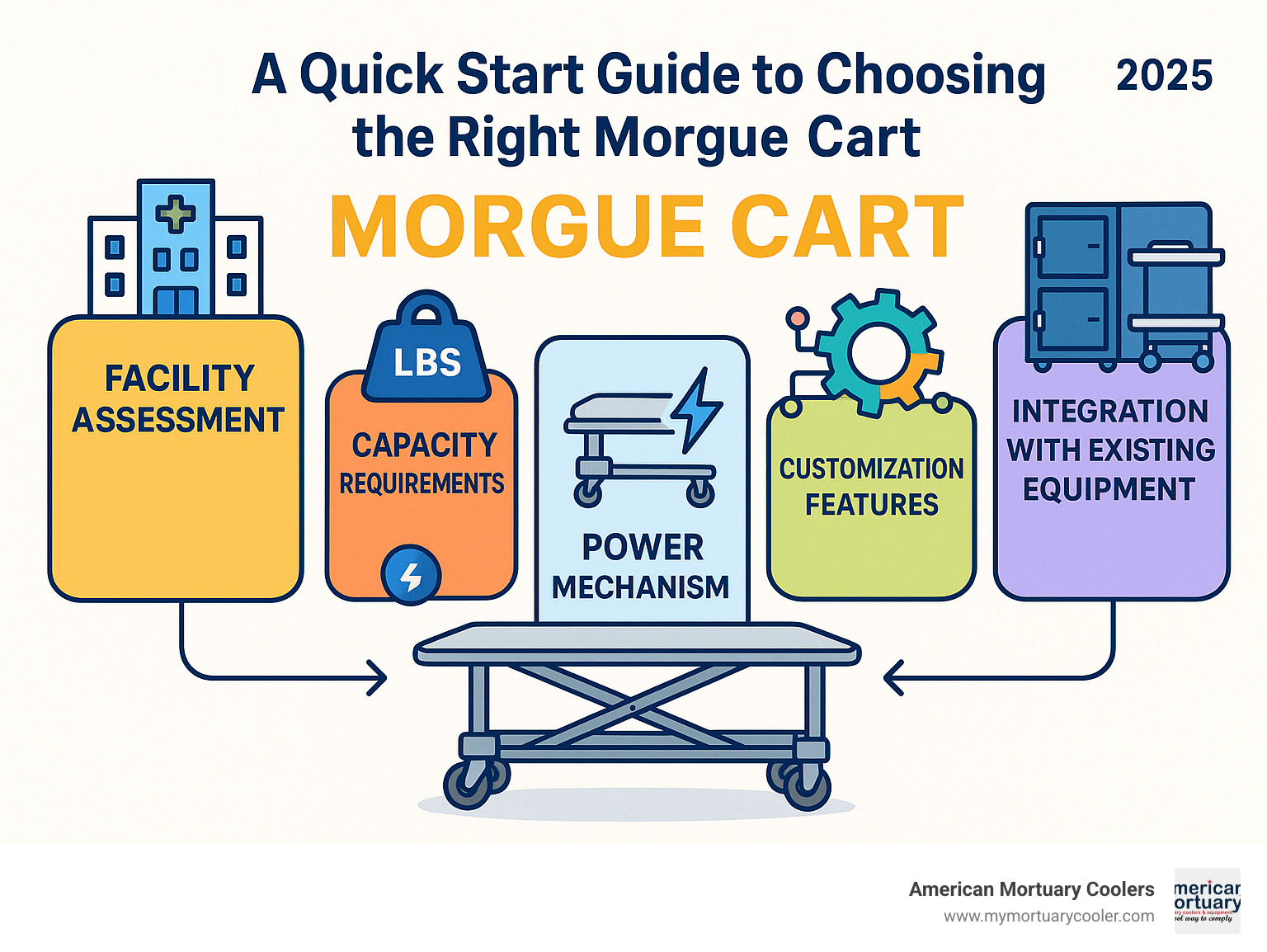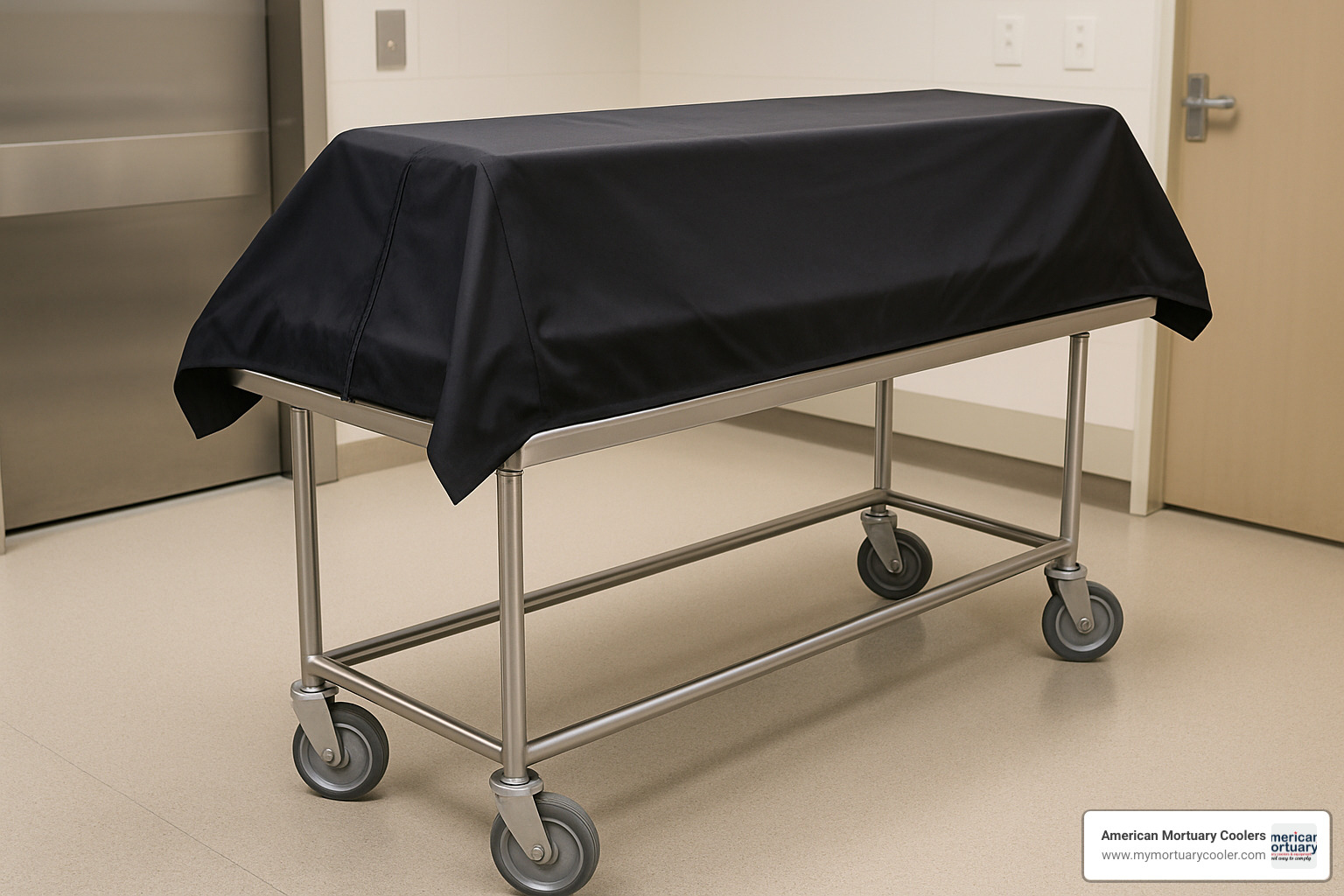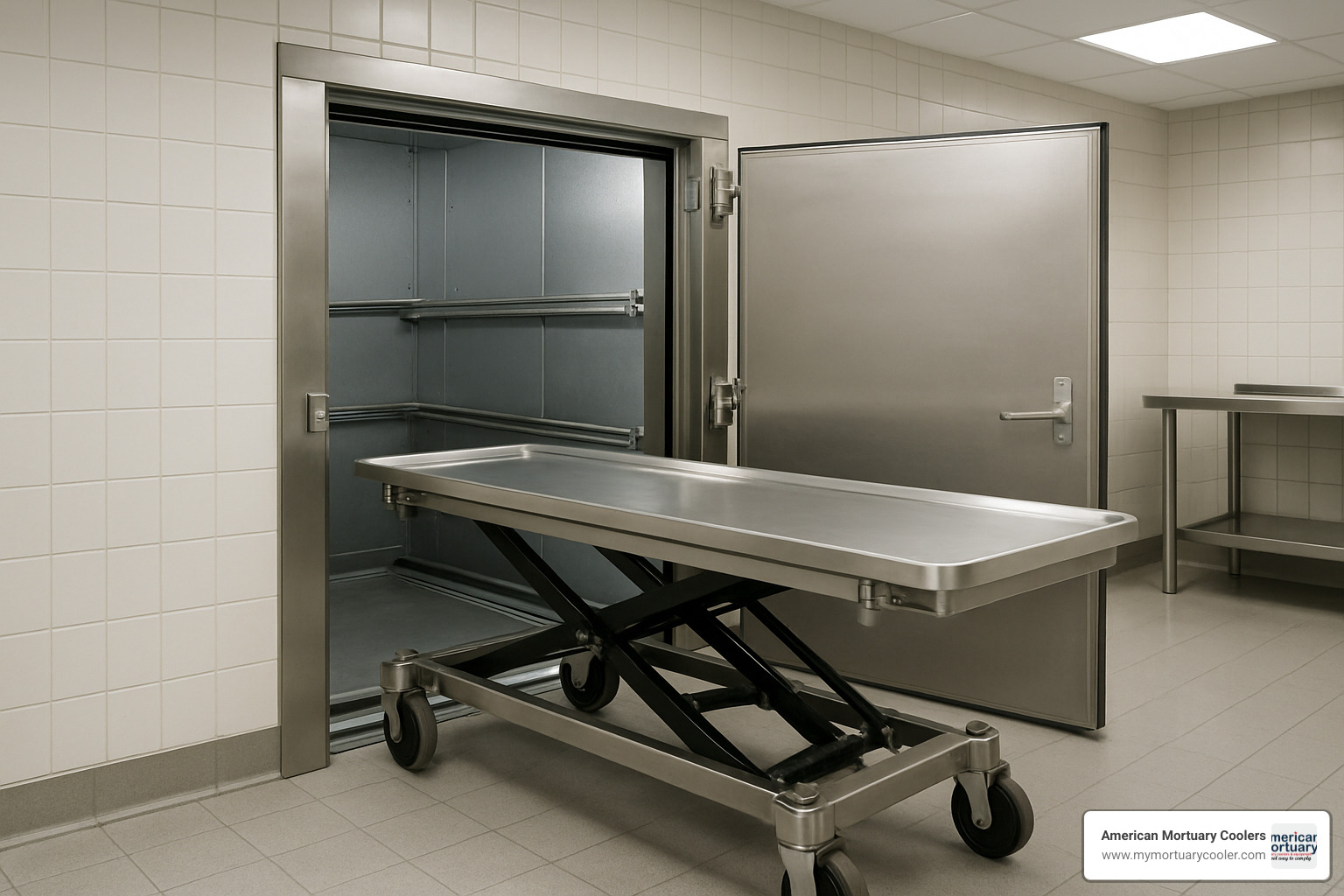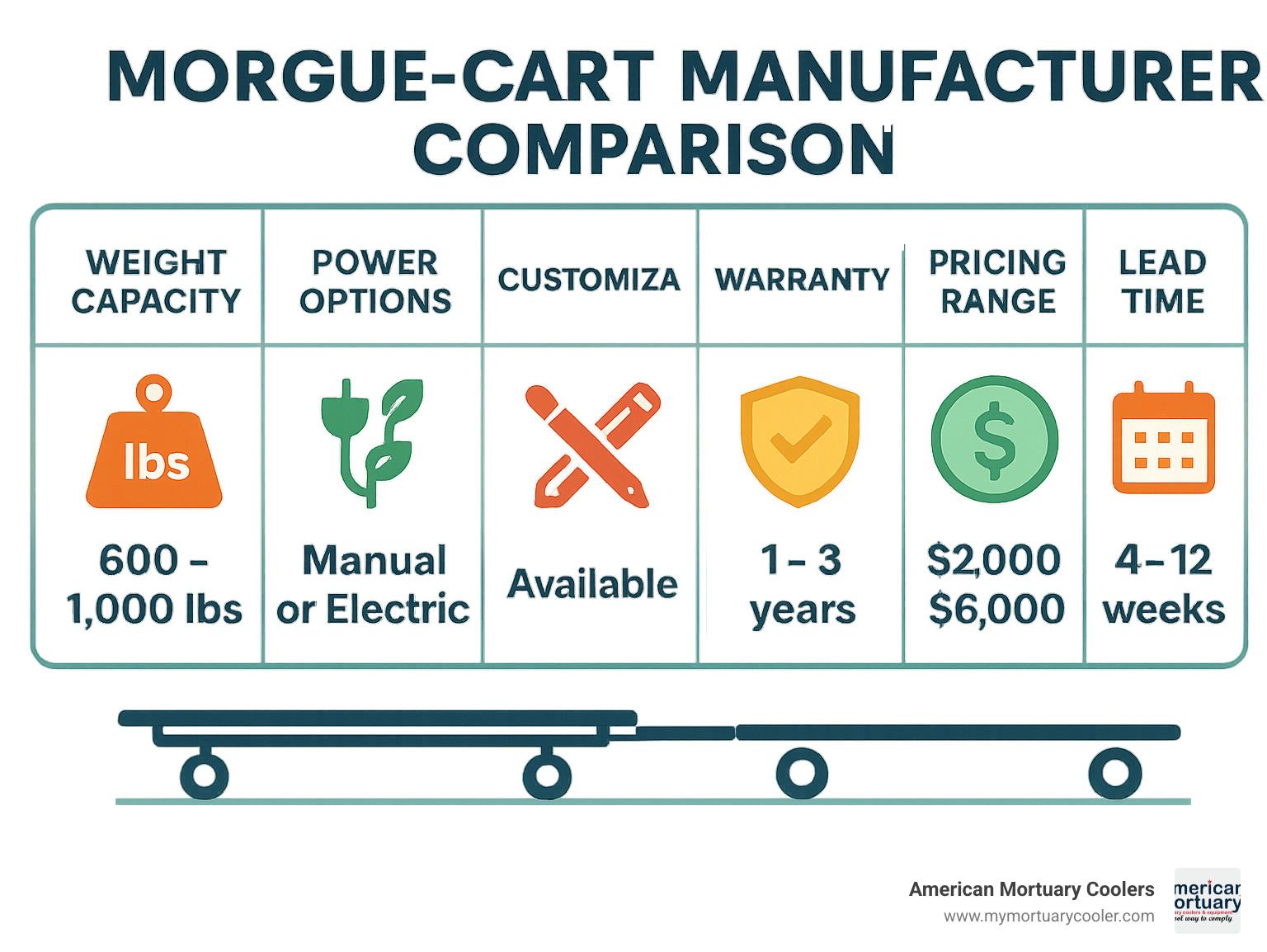Why Selecting the Right Morgue-Cart Is Critical for Your Facility
A morgue-cart is a specialized mobile platform designed to safely transport and handle human remains within mortuary, hospital, and pathology facilities. These essential pieces of equipment combine heavy-duty construction with ergonomic features to ensure dignified, hygienic, and efficient handling of deceased individuals throughout various stages of care.
Key morgue-cart functions include:
- Transport - Moving remains between refrigeration units, autopsy tables, and preparation areas
- Storage - Temporary holding with adjustable height trays (13.5" to 38")
- Concealment - Privacy during transport with covered designs
- Heavy-duty capacity - Supporting 300 to 1,000 lbs depending on model
- Mobility - Equipped with 5" to 8" lockable swivel casters
- Material construction - Built from 304 stainless steel for durability and sanitation
The right morgue-cart improves workflow efficiency while maintaining the respect and dignity that families expect during their most difficult moments. With options ranging from basic transport models to specialized bariatric units with hydraulic lifting mechanisms, choosing the correct cart directly impacts your facility's operational capacity and staff safety.
I'm Mortuary Cooler, a national-level mortuary equipment supplier with extensive experience helping funeral homes select the right morgue-cart solutions for their specific needs. My background includes working with facilities across the country to match cart specifications with workflow requirements, ensuring optimal performance and value for each investment.

Must-know morgue-cart terms:
Why This Guide Matters
Selecting the right morgue-cart isn't just about moving equipment from point A to point B - it's about creating a foundation for safe, efficient, and respectful operations. We've seen facilities struggle with workflow bottlenecks, staff injuries, and equipment failures simply because they didn't properly evaluate their cart requirements upfront.
From our experience serving funeral homes across Tennessee, Georgia, Illinois, and beyond, we know that the right cart selection directly impacts operational efficiency (reducing transfer times by up to 40%), staff safety (preventing back injuries from manual lifting), and maintaining dignity during the most sensitive moments of family interaction.
Understanding Morgue Carts: Core Functions & Main Types
Think of a morgue-cart as the workhorse of any mortuary facility. Just like hospitals rely on gurneys to move patients safely, funeral homes and pathology labs depend on these specialized carts to handle every aspect of body transport and preparation with dignity and efficiency.
The industry has evolved significantly from basic wheeled tables. Today's leading manufacturers like CSI Jewett, Mobimedical, and Spire Integrated Solutions have transformed morgue carts into sophisticated pieces of equipment. Whether you need a simple transport solution or a high-tech autopsy trolley with hydraulic positioning, there's a cart designed specifically for your workflow.
Modern morgue-cart systems handle the heavy lifting - literally and figuratively. They transport bodies from refrigeration to preparation areas, provide stable work surfaces during procedures, and ensure privacy during sensitive moments when families might be present.
What Is a Morgue-Cart?
At its core, a morgue-cart is a mobile platform engineered to safely transport and position human remains throughout your facility. These carts handle three primary tasks: body transfer between refrigeration units, preparation rooms, and autopsy suites; temporary storage during procedures; and serving as work surfaces during embalming or examination procedures.
The tray system is where the engineering really shines. These carefully designed platforms measure between 30" x 84" to 40.1" x 84" for bariatric models. The 304 stainless steel construction includes sloped or convex surfaces that channel fluids directly to drainage points, keeping your workspace clean and hygienic.
Height adjustment transforms a single cart into multiple tools. At 13.5", loading from a refrigeration unit becomes effortless. Crank it up to 38", and you have a comfortable working height that saves your staff's backs during longer procedures.
Types of Morgue-Carts You'll Encounter
Transport carts are the bread and butter of most facilities. These straightforward units focus on moving remains efficiently between locations. With manual height adjustment and weight capacities between 300-650 lbs, they handle the majority of daily transport needs without breaking the budget.
Autopsy trolleys step up the sophistication significantly. These professional-grade units include hydraulic lifting mechanisms for precise positioning, integrated drainage systems, and controls that let pathologists focus on their work rather than fighting with equipment. Bariatric autopsy trolleys can handle up to 1,000 lbs on a spacious 35" x 84" surface.
Concealed transport carts solve a problem many facilities face - maintaining privacy during transport through areas where families or visitors might be present. These clever designs appear completely empty when not loaded, providing dignity during sensitive moments. CSI Jewett offers seven different sizes with capacities from 300 to 1,000 lbs, available with manual, battery-powered, or hydraulic operation.

Bariatric units address the reality that standard 30" wide carts simply can't accommodate everyone with dignity. These specialized carts feature 40.1" wide trays and reinforced construction rated for 1,000 lbs. The extra width and strength ensure safe handling while maintaining the respect every individual deserves.
Surge racks and emergency response systems might seem like overkill until you need them. During mass casualty events or pandemic situations, these quick-deploy systems can rapidly expand your facility's capacity.
Cadaver stretcher carts blur the line between transport and work surface. These multipurpose units adapt to various procedures throughout the day, making them popular with smaller facilities that need equipment to wear multiple hats.
For more detailed information about smooth mortuary trolleys, our comprehensive guide covers the latest models and features that can streamline your operations.
Key Features & Specifications to Evaluate
When you're shopping for a morgue-cart, the specifications can feel overwhelming at first glance. But once you understand what matters most, the decision becomes much clearer.
Weight capacity sits at the top of your priority list. Most facilities find that 300-650 lb capacity handles their standard needs perfectly well. However, if you're serving a community where bariatric cases are common, investing in 1,000 lb capacity units from the start saves you from scrambling later.
The 304 stainless steel construction isn't just about looking professional. This material choice, combined with an 11-gauge frame, gives you the corrosion resistance and structural integrity that daily morgue operations demand. Cheaper alternatives might save money upfront, but they'll cost you dearly in repairs and replacements down the road.
Adjustable height capability makes the difference between staff who go home comfortable and staff who go home with aching backs. Most quality carts adjust from 13.5" to 38" - low enough for easy loading from refrigeration units, high enough for comfortable working positions during procedures.
Don't overlook your caster selection. Those 5" to 8" lockable swivel casters might seem like a small detail, but they're what make the difference between smooth, quiet operation and carts that fight you every step of the way. Quality casters with reliable locking mechanisms prevent those heart-stopping moments when equipment starts rolling during critical procedures.
Tray styles affect both your daily workflow and cleaning efficiency. Sloped surfaces with integrated drainage work beautifully for autopsy procedures, channeling fluids exactly where they need to go. Flatter surfaces might suit preparation work better.
For more detailed insights into what makes some trolleys operate more smoothly than others, our guide on smooth mortuary trolleys covers the technical details that can make or break your daily operations.
Power Mechanisms: Manual, Hydraulic, Battery
The power mechanism you choose shapes your daily experience with the cart more than almost any other feature. Each option has its place, and understanding the trade-offs helps you make the right choice for your specific situation.
Manual crank systems are the workhorses of the morgue cart world. They require some elbow grease - typically 15-20 turns to go from lowest to highest position - but they never let you down. No power failures, no hydraulic leaks, no dead batteries. Just reliable mechanical operation that keeps working year after year with minimal maintenance.
Hydraulic mechanisms feel almost magical when you first use them. A simple foot pump gives you smooth, effortless height adjustment with precise control. Your staff will love the convenience, especially during long procedures. The downside? Hydraulic systems need regular maintenance, and when they fail, they can create messy cleanup situations.
Battery-powered systems offer the best of both worlds for many facilities. Push-button convenience without the mess potential of hydraulics. Modern lithium-ion systems provide hundreds of adjustment cycles per charge, and you can easily track battery levels to avoid surprises. The main considerations are setting up charging stations and planning for eventual battery replacement.
| Feature | Manual Crank | Hydraulic | Battery-Powered |
|---|---|---|---|
| Reliability | Excellent | Good | Very Good |
| Ease of Use | Moderate | Excellent | Excellent |
| Maintenance | Minimal | Regular | Moderate |
| Power Required | None | None | Charging Station |
| Typical Cost | Lowest | Moderate | Highest |
Customization Options That Matter
Every facility has unique needs, and that's where customization options really shine. The right accessories can transform a standard morgue-cart into a perfectly custom solution for your specific workflow.
Covers and concealment options go far beyond basic privacy. Simple drapes work fine for internal transport, but if you're moving carts through areas where families might be present, sophisticated concealed systems that appear completely empty make all the difference. Color-coding systems help staff instantly identify different case types or maintain proper workflow separation.
Bridge sets and transfer accessories solve one of the most challenging aspects of morgue operations - moving remains safely between different pieces of equipment. Quality stainless steel bridge sets provide secure temporary support during transfers to autopsy tables or embalming stations, eliminating the awkward lifting that can lead to injuries.
Ramps and loading aids might seem like luxury items until you need them. Facilities with elevation changes or specialized loading requirements find these accessories invaluable for maintaining smooth operations.

Side rails and safety features provide that extra peace of mind during transport while maintaining easy access for procedures. Removable rails offer the flexibility to adapt to different operational needs throughout the day.
Safety, Hygiene & Regulatory Essentials
When it comes to morgue-cart operations, safety isn't just a recommendation - it's literally a matter of life and death for your staff. Most safety protocols are straightforward once you understand the basics.
Biohazard control starts with recognizing that every case presents potential risks. OSHA doesn't mess around when it comes to protecting workers who handle human remains. Their regulations require proper personal protective equipment (PPE) for every interaction, from simple transport to complex procedures. This means gloves, gowns, eye protection, and sometimes respiratory protection depending on the situation.
The AATB standards add another layer of requirements, especially if your facility handles tissue recovery or transplant procedures. These guidelines govern everything from initial handling to final disposition, ensuring that tissue integrity and safety remain paramount throughout the process.
Privacy considerations extend far beyond being respectful to grieving families. HIPAA compliance means protecting patient information even after death. This affects how you label carts, store documentation, and discuss cases within your facility.
Good morgue-cart design really shines here. The 304 stainless steel construction isn't just about durability - it's specifically chosen because it plays well with hospital-grade disinfectants. You can thoroughly clean between uses without worrying about corrosion or material degradation.
Floor drains and sloped surfaces might seem like minor details, but they're game-changers for contamination control. Proper fluid management prevents biological material from spreading to surrounding areas, keeping your facility safe and compliant.
Don't overlook those swivel locks on your casters. They prevent unwanted movement during procedures, which reduces the risk of accidents, spills, and potentially dangerous situations.
For comprehensive information about cleaning protocols and chemical compatibility, refer to cleaning chemistries resources from industry suppliers.
Cleaning & Maintenance Best Practices
Cleaning a morgue-cart isn't glamorous work, but doing it right protects everyone and extends your equipment's life significantly.
Daily wipe-down procedures should become second nature for your staff. Use hospital-grade cleaners that are specifically compatible with stainless steel. Pay extra attention to those tricky spots around height adjustment mechanisms and caster mounting points where biological material loves to hide.
The key is being thorough without being obsessive. Hit all surfaces, including the underside of trays and any crevices where fluids might accumulate. This daily routine prevents buildup that becomes much harder to address later.
Weekly deep cleaning takes things to the next level. This involves disassembling removable components for thorough sanitization. Remove and clean tray inserts separately, inspect drainage systems for any blockages, and lubricate mechanical components according to the manufacturer's specifications.
This weekly routine is also your chance to spot potential problems before they become expensive repairs. Look for signs of wear, unusual corrosion, or mechanical issues that need attention.
304 stainless steel care requires a bit of finesse. Always clean in the direction of the grain to prevent scratching that can harbor bacteria. Avoid chloride-based cleaners like the plague - they can cause pitting that's both unsightly and unsanitary.
Always rinse thoroughly after disinfection. Chemical residue buildup not only looks unprofessional but can also interfere with future cleaning efforts and potentially damage the steel over time.
Lubrication points typically include height adjustment mechanisms, caster bearings, and locking mechanisms. Use only food-grade lubricants approved for medical equipment. This prevents any contamination concerns while keeping everything moving smoothly.
For additional guidance on lifting equipment maintenance, consult our mortuary lifting equipment buying guide.
Standards That Shape Morgue-Cart Design
Understanding the standards behind morgue-cart design helps explain why certain features exist and why some carts cost more than others.
Healthcare building codes specify minimum corridor widths, door clearances, and accessibility requirements that directly impact cart dimensions. Those standard morgue-cart widths of 28.3" to 40.1" aren't arbitrary - they're carefully calculated to accommodate most facility layouts while providing the capacity you need.
These codes also influence things like turning radius requirements and maximum cart lengths. A cart that can't steer your facility's hallways and doorways is expensive scrap metal, regardless of how well-built it might be.
Bariatric guidelines from healthcare organizations have significantly influenced modern cart design. The increasing prevalence of bariatric cases has driven demand for 1,000 lb capacity carts with 40" tray widths. These aren't just bigger versions of standard carts - they require completely different engineering approaches to handle the increased loads safely.
ADA pathway requirements ensure that morgue-cart operations don't impede accessibility in multi-use facilities. This affects both where you can store carts and how you operate them in shared spaces like hospital corridors.
Choosing the Right Morgue-Cart for Your Facility
Facility assessment begins with understanding your specific workflow requirements, average caseload, and physical constraints. Door clearances, elevator dimensions, and floor transitions all impact cart selection. A cart that works perfectly in one facility may be completely unsuitable for another due to infrastructure differences.
Workload analysis should consider both current needs and future growth projections. A facility handling 200 cases annually has different requirements than one processing 1,000+ cases. Peak capacity planning becomes critical during flu seasons or other events that may temporarily increase caseload.
Lift compatibility and refrigeration integration require careful coordination between different equipment manufacturers. Cart tray heights must align with refrigeration unit rail systems, while transfer mechanisms need to accommodate existing autopsy tables and preparation equipment.

Workflow mapping helps identify bottlenecks and inefficiencies that proper cart selection can address. We've seen facilities reduce case processing time by 30% simply by choosing carts with better height adjustment mechanisms and improved mobility features.
Integrating a Morgue-Cart With Existing Equipment
Refrigerator Rail Systems vary between manufacturers, requiring careful measurement and sometimes custom adapters. CSI Jewett carts, for example, are designed to work seamlessly with their refrigeration units but may require modifications for other brands.
Autopsy Table Height Compatibility ensures smooth transfers without manual lifting. Standard autopsy table heights range from 32" to 38", so cart adjustment ranges must overlap these dimensions for safe transfers.
Scissor Lift Integration can eliminate manual transfer requirements entirely. Some facilities invest in portable cadaver scissor lifts that work with standard carts to provide automated positioning.
Cross-Brand Compatibility often requires custom fittings or adapters. We work with facilities to ensure new carts integrate properly with existing equipment, sometimes requiring minor modifications to achieve optimal workflow.
For more information about storage integration, see our guide on morgue storage racks.
Budget, Lead Time & Supplier Comparison
CSI Jewett (Spire Integrated Solutions) offers the most comprehensive product line with seven different concealed cart sizes and extensive customization options. Their Made in USA manufacturing provides quality assurance but typically involves longer lead times and higher costs.
Mortech Manufacturing specializes in emergency response and surge capacity solutions, including the patented MERC System for direct-contact liquid cooling. Their focus on rapid deployment makes them ideal for facilities needing temporary expansion capability.
Mobimedical provides cost-effective solutions with standard cadaver stretcher carts offering 650 lb capacity and basic functionality. Their products typically offer shorter lead times and competitive pricing for budget-conscious facilities.
Spire Integrated Solutions encompasses multiple brands including CSI Jewett, providing comprehensive equipment packages with coordinated compatibility. Their integrated approach simplifies procurement but may limit flexibility in mixing brands.
When comparing suppliers, consider total cost of ownership including maintenance, parts availability, and warranty coverage. A lower initial purchase price may result in higher long-term costs if service support is inadequate.
For direct manufacturer contact information, visit construction industry contacts for comprehensive supplier listings.

Frequently Asked Questions about Morgue Carts
After helping funeral homes and medical facilities across Tennessee, Georgia, and beyond select the perfect morgue-cart for their needs, we've noticed the same questions come up time and again. These aren't just technical concerns - they reflect the real challenges you face when trying to balance operational efficiency with budget constraints and space limitations.
Let me share the most common questions we hear, along with the practical answers that have helped dozens of facilities make confident decisions.
What dimensions and weight capacity should I choose?
The standard 30" x 84" tray with 650 lb capacity works perfectly for most funeral homes and smaller medical facilities. This size fits through standard doorways and handles the majority of cases you'll encounter without breaking your budget.
But here's what we've learned from our customers: demographics matter more than you might think. Facilities in certain regions consistently need bariatric capability, while others rarely encounter cases requiring extra capacity.
Bariatric units with 40.1" x 84" trays and 1,000 lb capacity cost significantly more upfront, but they prevent workflow disruptions and protect your staff from injury when handling larger individuals. We've seen facilities struggle for years with inadequate capacity before finally upgrading - don't make that mistake.
Door clearance calculations are surprisingly tricky. Your 40" morgue-cart needs at least 44" of clear opening width for comfortable maneuvering, especially around corners. Measure twice, order once - we've had to coordinate returns because carts couldn't steer tight hallways.
How often should a morgue-cart be serviced?
Daily attention takes just five minutes but prevents expensive problems down the road. Wipe down all surfaces, test the height adjustment mechanism, and check that caster locks engage properly. Your staff will naturally notice issues during daily use - listen to their feedback.
Monthly deep maintenance involves lubricating moving parts and thoroughly cleaning mechanical components. This isn't glamorous work, but it extends equipment life dramatically. Document everything for warranty purposes - manufacturers want to see consistent care.
Annual professional service by qualified technicians catches problems before they cause downtime. We've seen facilities avoid major repairs simply because a technician spotted worn components during routine service. The service call cost pays for itself many times over.
What's the difference between a cart and a full stretcher system?
Morgue-carts excel at stationary positioning and workspace functionality within your facility. They're built like tanks - heavy, stable, and designed for repeated loading cycles at autopsy tables and preparation stations.
Stretcher systems prioritize mobility and transport features. They include things like stair-climbing capability and rapid height adjustment for emergency situations. The trade-off is typically lighter construction and higher complexity.
Hybrid solutions attempt to combine both capabilities, but they come with increased cost and mechanical complexity. Most facilities find better value in selecting the right tool for their primary need rather than compromising with a jack-of-all-trades approach.
For comprehensive guidance on finding the right morgue-cart for your specific situation, check out our detailed guide on finding a morgue cart that covers selection criteria and purchasing tips.
Conclusion
Choosing the right morgue-cart feels overwhelming at first, but it really comes down to understanding your facility's unique needs. We've walked through everything from basic transport carts to sophisticated bariatric units, and the truth is that there's no one-size-fits-all solution. What works perfectly for a small funeral home in rural Tennessee might be completely wrong for a busy urban morgue in Chicago.
The investment you make today in quality equipment will pay you back through smoother daily operations, fewer staff injuries, and the peace of mind that comes from knowing your equipment won't let you down when families need you most. We've seen too many facilities struggle with cheap equipment that breaks down at the worst possible moments.
At American Mortuary Coolers, we've been helping funeral homes and morgue facilities across the country make these important decisions for years. Our team understands that every facility is different, and we take the time to really understand your workflow before making recommendations. Whether you're in Tennessee, Georgia, Illinois, or anywhere else in the contiguous 48 states, we're here to help you find the right solution.
The best next step is to take a honest look at your current operations. Walk through your typical day and notice where things slow down or where your staff struggles. Maybe your current cart is too heavy to move easily, or perhaps the height adjustment takes too long. These pain points are exactly what the right morgue-cart can solve.
Start by measuring your doorways, checking your refrigeration unit compatibility, and thinking about whether you need bariatric capacity. Don't forget to consider your future needs too - it's much easier to buy the right cart now than to replace it in a few years.
For more detailed guidance on the selection process, our ultimate guide to finding a morgue cart walks through everything step by step.
We're always happy to talk through your specific situation and help you figure out what makes the most sense for your facility. After all, the right equipment isn't just about efficiency - it's about maintaining the dignity and respect that every family deserves during their most difficult time.
















